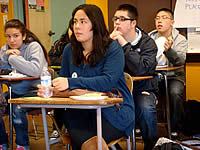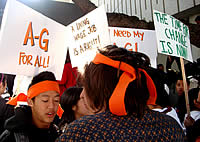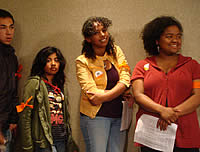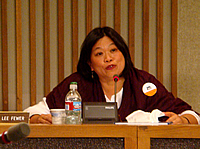by Barbara Cervone
SAN FRANCISCO, CA—It’s lunchtime at Balboa High School, once one of San Francisco’s most troubled schools but now on the rebound. Twenty-five students grab a sandwich and a seat, in good spirits on one of the last days of school. They are all members of Youth Making a Change (YMAC), a veteran youth organizing program in San Francisco.
“If you can hear me, clap once. If you can hear me, clap twice. If you can hear me, clap three times,” says MK Nguyen, YMAC’s youth coordinator and mentor for these Balboa students. “Let’s check in real quick. Just so we know who’s in the room, say your name and your grade and what you want to be.”
“My name is Daniela, and when I grow up I want to be a therapist.”
“Jen, when I grow up I want to work in law enforcement.”
“I’m Christine, I’m a sophomore, and I want to be a marine biologist.”
Aspirations fill the air. A journalist, a professor teaching Asian-American studies, an archaeologist, a doctor, a graphic designer, a lawyer, a musician, a CEO. In a state that ranks 47th in public spending per pupil—but has the eighth largest economy in the world—young people do not lack for ambitions.
And they will organize to make them reality. In six hours, the San Francisco Board of Education will vote on a policy these students have fought for all year long: to make the “A through G” course curriculum, required for admission to California’s state universities and colleges, the default curriculum for all students in the San Francisco Unified School District.
Daniela and her classmates, who have been planning for this evening for weeks, discuss what remains to be done—from finishing signs for the outdoor rally preceding the meeting to finalizing transportation for the 150 students citywide who plan to attend.
The stakes are high. “Tonight, when the Board of Education votes, we will turn up in massive numbers, to let folks know we can,” says Nguyen. “There are a lot of folks who think you can’t meet the rigor of ‘A through G.’ What do we say to them?”
“Yes we can,” students answer. But “I can’t hear you!” responds Nguyen.
“Si se puede!” the group cheers.
Worth fighting for
For over thirty years, San Francisco’s Coleman Advocates for Children and Youth, home to Youth Making a Change, has said “Yes we can,” determined to make San Francisco a city of hope, justice, and opportunity for all children and their families. They have pioneered a hybrid model of policy advocacy and grassroots organizing, with the leadership development of youth and parents of color at the center. Whether securing a stop sign for a busy neighborhood intersection or expanding the city-funded safety net for low-income families, Coleman Advocates has a track record of winning campaigns.
In 2005, after a year of intense discussion, Coleman’s staff, board, youth, and parents decided to sharpen their focus. They settled on two issues they believed were pivotal to strengthening the lives of Coleman’s constituents and the city they love: closing the racial achievement gap in San Francisco’s public schools, and increasing affordable housing for working families.
“We dove deep,” explains Coleman’s executive director, N’Tanya Lee. “We asked our youth and parents about their aspirations and dreams. What we heard was so simple, yet so daunting: they wanted to live and successfully raise their families in San Francisco, instead of being pushed out of their own city for lack of education and money. They wanted an education system that ensured that the thousands of low-income young people of color living in San Francisco today would become the city’s next generation of working people, homeowners, and civic leaders.”
As the group looked for points of leverage, they kept returning to the “A–G” curriculum: a fifteen-course sequence California high school students must complete to enter the state’s vast system of universities and four-year colleges. What if “A–G” was not just for students whose advantages won them the label “college bound,” but required of all secondary school students in San Francisco?
Making “A-G” the default curriculum, they decided, could transform the city’s schools, raising the bar for Pacific Islander, Latino, and African-American students who had struggled for years against low expectations. Convincing the San Francisco Board of Education to enact this change became their target.
Youth as action researchers
“Before, I was looking at the world through a one-dimensional lens,” explains Dan, a Balboa High School junior. “But the more I learned from MK, she’s like a mentor, and the more I read and looked around me, the more dimensions I saw. I saw that the honors track in my school was all white kids. I saw how at an early age, schools sorted kids into different futures, based on the color of their skin.”
The catalyst for Dan and many of his YMAC peers was as simple as an invitation to come to a campus meeting to talk about what’s happening around them. Not all youth join Coleman in the subsequent deep analysis of the root causes of issues they care about, but some do. They take on the role of researchers, surveying the landscape and developing questions. Coleman staff, like MK Nguyen, connects them to policy wonks, activists, and community or school leaders who can answer their questions or critique their analysis. The youth bring the results of their interviews back to the larger group—often including data from surveys they have administered—and figure out how and where to take action.
“This is how we landed on A–G,” says Dan. “We decided it was the most important thing to tackle if we wanted equal education opportunities for all the city’s youth.”
Standing witness
 When the San Francisco Board of Education called itself to order on the evening of May 26, 2009, over 200 students and parents crowded the room. Fifty youth and parents stood in line for almost two hours to speak on behalf of “A–G” for all, when it came up for consideration. Facing a packed agenda that could stretch past midnight, Board President Kim-Shree Maufas decided to confine the Coleman testimony to fifteen speakers and a one-minute limit.
When the San Francisco Board of Education called itself to order on the evening of May 26, 2009, over 200 students and parents crowded the room. Fifty youth and parents stood in line for almost two hours to speak on behalf of “A–G” for all, when it came up for consideration. Facing a packed agenda that could stretch past midnight, Board President Kim-Shree Maufas decided to confine the Coleman testimony to fifteen speakers and a one-minute limit.
“My name is Roso Rodriguez, I’m a student at International Studies Academy, and to me it looks like A through G is only for the privileged few . . .” “My name is Annalisa, I’m a fifth grader, and A through G classes are super important to me because in the future I want to be a good dentist . . .” “My name is Eric Eastem, I’m a junior at Balboa High School, and I’m here to fight, oddly, for an education . . . One great example of a student of color who was given a chance is Sonia Sotomayor.”
One after another, students approached the microphone and shared their stories and dreams. A parent presented 3,000 postcards Coleman youth and parents had collected from across the city, proclaiming support for “A–G.”
 “Wow,” began Commissioner Sandra Lee Fewer in opening comments from the Board: “I think the most important part of this resolution is ‘allow students across the district to experience consistent expectations and requirements,’ which is something we have not done. Shame on us as a society.” Other Board members echoed her passion. “In my four plus years on this board, this is the probably the most important policy I’ve gotten to vote on,” said Commissioner Norman Yee. “It’s bigger than apple pie.” The Board continually wrestles with how a specific policy will affect students, noted Commissioner Hydra Mendoza: “Your testimony tonight gave us credit to do this, to move forward. Thank you, students, for allowing us to har your voice.”
“Wow,” began Commissioner Sandra Lee Fewer in opening comments from the Board: “I think the most important part of this resolution is ‘allow students across the district to experience consistent expectations and requirements,’ which is something we have not done. Shame on us as a society.” Other Board members echoed her passion. “In my four plus years on this board, this is the probably the most important policy I’ve gotten to vote on,” said Commissioner Norman Yee. “It’s bigger than apple pie.” The Board continually wrestles with how a specific policy will affect students, noted Commissioner Hydra Mendoza: “Your testimony tonight gave us credit to do this, to move forward. Thank you, students, for allowing us to har your voice.”
Just before nine p.m., the Board voted unanimously to adopt “A–G” as the default curriculum for all San Francisco high schools. “I’ll always remember that minute,” said tenth-grader Shana, as she and her classmates slapped hands in victory.
Hard work ahead
“I’ve never seen our youth so pumped, so juiced,” director N’Tanya Lee said the next morning. “They knew they did it. They helped gather those postcards, they talked to their teachers, they met with every single one of those school board members.”
They and their adult allies also know that the gap between policy and real action can be as large as the achievement gap itself. At a time when the San Francisco school district faces the biggest budget cuts in its history, enacting a bold new reform plan seems a Herculean struggle. A week after the Board of Education approved “A–G” for all, it was forced to close summer school across the district, just days before it was to start.
Director N’Tanya Lee counts on Coleman’s youth members to apply pressure. “We want to have well-supported teams of students—and parents—who can document the daily practices in schools, who can say, ‘This is where things are working and this is where they aren’t.’ We’re in this for the long haul—and who better to keep the system accountable than the students, themselves?”
“I’m Christine, I’m a sophomore, and I want to be a marine biologist.”




